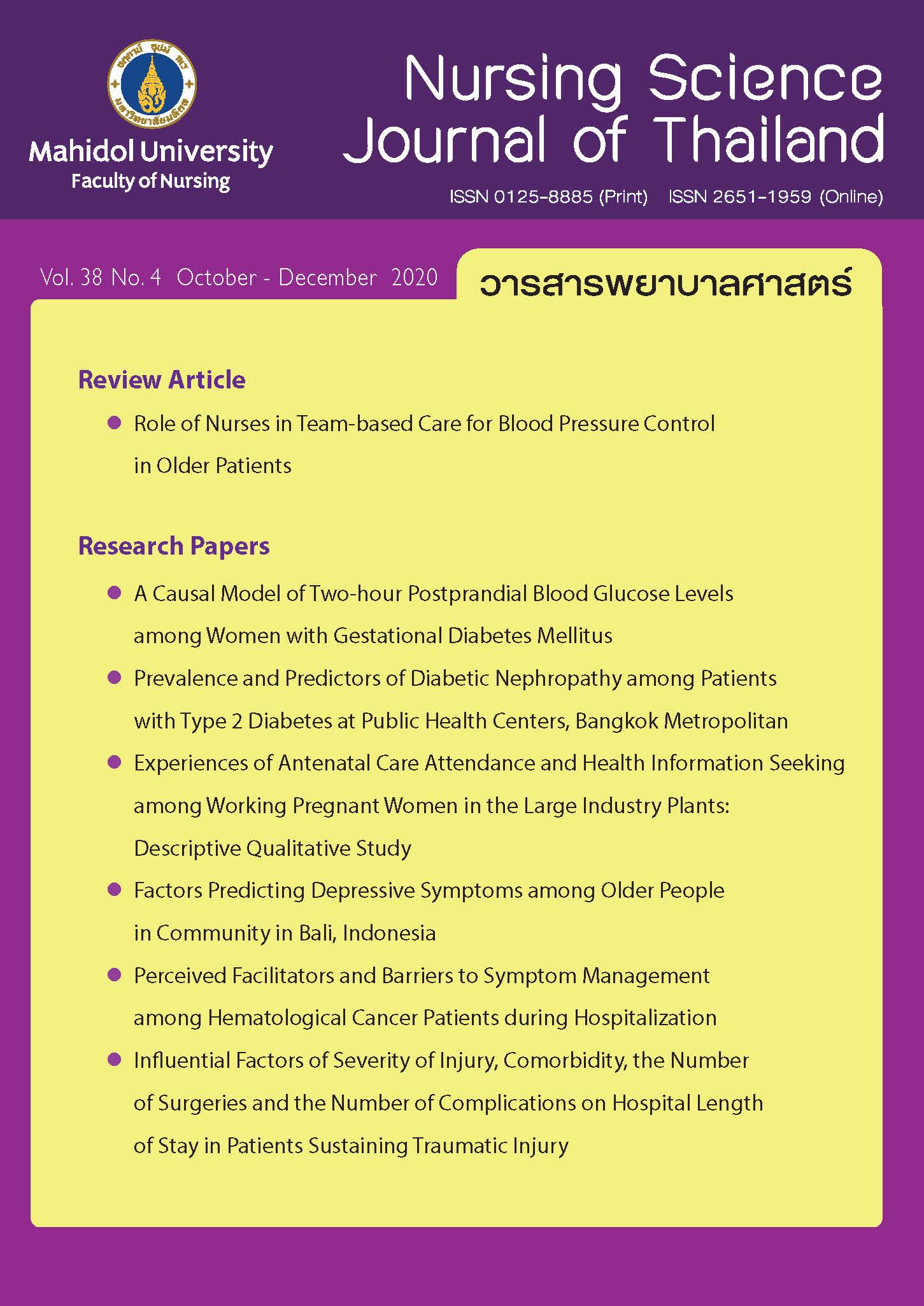รูปแบบความสัมพันธ์เชิงสาเหตุของค่าน้ำตาลในเลือดหลังรับประทานอาหาร 2 ชั่วโมง ในสตรีที่มีภาวะเบาหวานขณะตั้งครรภ์
Main Article Content
บทคัดย่อ
วัตถุประสงค์: การศึกษาครั้งนี้มีวัตถุประสงค์เพื่อทดสอบความสัมพันธ์เชิงสาเหตุของความรุนแรงของโรค การสนับสนุนทางสังคม การรับรู้สมรรถนะแห่งตน และการจัดการตนเอง ต่อค่าน้ำตาลในเลือดหลังรับประทานอาหาร 2 ชั่วโมง ของสตรีที่มีภาวะเบาหวานขณะตั้งครรภ์
รูปแบบการวิจัย: การศึกษารูปแบบความสัมพันธ์เชิงสาเหตุ
วิธีดำเนินการวิจัย: กลุ่มตัวอย่าง คือ สตรีที่มีภาวะเบาหวานขณะตั้งครรภ์ จำนวน 174 คน คัดเลือกด้วยการสุ่มแบบเป็นระบบ เครื่องมือที่ใช้ในการวิจัย ได้แก่ แบบบันทึกข้อมูลทั่วไป แบบสอบถามการรับรู้สมรรถนะแห่งตน แบบสอบถามการสนับสนุนทางสังคม และแบบสอบถามการจัดการตนเอง วิเคราะห์ข้อมูลโดยใช้สถิติเชิงพรรณนาและการวิเคราะห์เส้นทางความสัมพันธ์เชิงสาเหตุ
ผลการวิจัย: ผลการตรวจสอบความสัมพันธ์เชิงสาเหตุพบว่า ความรุนแรงของโรค การสนับสนุนทางสังคม การรับรู้สมรรถนะแห่งตน และการจัดการตนเอง อธิบายความแปรปรวนของค่าน้ำตาลในเลือดหลังรับประทานอาหาร 2 ชั่วโมง ได้ร้อยละ 24.9 (R2 = .249) ค่าความสอดคล้องของแบบจำลองที่ลดรูปมีค่าสถิติอยู่ในเกณฑ์ที่ยอมรับได้ (2 = 8.64, df = 4, p = .07;
2/df = 2.16; CFI =.99; GFI = .98; AGFI = .93; RMSEA = .08) โดยการจัดการตนเองมีอิทธิพลโดยตรงทางลบต่อค่าน้ำตาลในเลือดหลังรับประทานอาหาร 2 ชั่วโมง (β = - .50, p < .001) การรับรู้สมรรถนะแห่งตนมีอิทธิพลโดยตรงทางบวกต่อการจัดการตนเอง (β = .63, p < .001) นอกจากนี้ การสนับสนุนทางสังคมมีอิทธิพลโดยตรงทางบวกต่อการรับรู้สมรรถนะแห่งตนและการจัดการตนเอง (β = .52, p < .001; β = .26, p < .001 ตามลำดับ) ส่วนความรุนแรงของโรคมีอิทธิพลโดยตรงทางลบต่อการรับรู้สมรรถนะแห่งตน (β = - .25, p < .001)
สรุปและข้อเสนอแนะ: การรับรู้สมรรถนะแห่งตนและการสนับสนุนทางสังคมเป็นปัจจัยที่มีอิทธิพลโดยตรงทางบวกต่อการจัดการตนเอง และอิทธิพลโดยอ้อมทางลบต่อค่าน้ำตาลในเลือด ผ่านการจัดการตนเอง พยาบาลและบุคลากรสาธารณสุขสามารถนำไปใช้เป็นแนวทางในการพัฒนารูปแบบการสนับสนุนการจัดการตนเองแก่สตรีที่มีภาวะเบาหวานขณะตั้งครรภ์ เพื่อควบคุมค่าน้ำตาลในเลือดให้อยู่ในเกณฑ์ปกติ
Article Details
ลิขสิทธิ์: วารสารพยาบาลศาสตร์เป็นเจ้าของลิขสิทธิ์ในการเผยแพร่ผลงานที่ตีพิมพ์ ห้ามผู้ใดนำบทความที่ได้รับการตีพิมพ์ในวารสารพยาบาลศาสตร์ไปเผยแพร่ในลักษณะต่างๆ ดังต่อไปนี้ การส่งบทความไปตีพิมพ์เผยแพร่ที่อื่น การนำบทความเผยแพร่ออนไลน์ การถ่ายเอกสารบทความเพื่อกิจกรรมที่ไม่ใช่การเรียนการสอน ยกเว้นเสียแต่ได้รับอนุญาตจากวารสารพยาบาลศาสตร์

Disclaimer: เนื้อหาบทความหรือข้อคิดเห็นใดๆ ในวารสารพยาบาลศาสตร์ ถือเป็นความรับผิดชอบของผู้เขียน กองบรรณาธิการไม่จำเป็นต้องเห็นด้วยและไม่มีส่วนรับผิดชอบแต่อย่างใด
เอกสารอ้างอิง
Zhu Y, Zhang C. Prevalence of gestational diabetes and risk of progression to type 2 diabetes: a global perspective. Curr Diab Rep. 2016;16(1):7. doi: 10.1007/s11892-015-0699-x.
Lee KW, Ching SM, Ramachandran V, Yee A, Hoo FK, Chia YC, et al. Prevalence and risk factors of gestational diabetes mellitus in Asia: a systematic review and meta-analysis. BMC Pregnancy Childbirth. 2018;18(1):494. doi: 10.1186/s12884-018-2131-4.
Committee on Practice Bulletins—Obstetrics. ACOG practice bulletin No. 190: gestational diabetes mellitus. Obstet Gynecol. 2018;131(2):e49-e64. doi: 10.1097/AOG.0000000000002501.
Grey M, Knafl K, McCorkle R. A framework for the study of self- and family management of chronic conditions. Nurs Outlook. 2006;54(5):278-86. doi: 10.1016/j.outlook.2006.06.004.
Martis R, Brown J, McAra-Couper J, Crowther CA. Enablers and barriers for women with gestational diabetes mellitus to achieve optimal glycaemic control – a qualitative study using the theoretical domains framework. BMC Pregnancy Childbirth. 2018;18(1):91. doi: 10.1186/s12884-018-1710-8.
Schmitt A, Reimer A, Hermanns N, Huber J, Ehrmann D, Schall S, et al. Assessing diabetes self-management with the Diabetes Self-Management Questionnaire (DSMQ) can help analyse behavioural problems related to reduced glycaemic control. PLos One. 2016;11(3):e0150774. doi: 10.1371/journal.pone.0150774.
Nelson KM, McFarland L, Reiber G. Factors influencing disease self-management among Veterans with diabetes and poor glycemic control. J Gen Intern Med. 2007;22(4):442-7. doi: 10.1007/s11606-006-0053-8.
Bandura A. Self-efficacy. In: Ramachaudran VS, editor. Encyclopedia of human behavior. Vol. 4. New York, NY: Academic Press; 1994. p.71-81.
Gunggu A, Thon CC, Whye Lian C. Predictors of diabetes self-management among type 2 diabetes patients. J Diabetes Res. 2016;2016:9158943. doi: 10.1155/2016/9158943.
Dao-Tran TH, Anderson D, Chang A, Seib C, Hurst C. Factors associated with self-management among Vietnamese adults with type 2 diabetes. Nurs Open. 2018;5(4):507-16. doi: 10.1002/nop2.158.
Somers TJ, Shelby RA, Keefe FJ, Godiwala N, Lumley MA, Mosley-Williams A, et al. Disease severity and domain-specific arthritis self-efficacy: relationships to pain and functioning in patients with rheumatoid arthritis. Arthritis Care Res. 2010;62(6):848-56. doi: 10.1002/acr.20127.
Alzubaidi H, Mc Narmara K, Kilmartin GM, Kilmartin JF, Marriott J. The relationships between illness and treatment perceptions with adherence to diabetes self-care: a comparison between Arabic-speaking migrants and Caucasian English-speaking patients. Diabetes Res Clin Pract. 2015;110(2):208-17. doi: 10.1016/j.diabres.2015.08.006.
Carolan M, Gill GK, Steele C. Women's experiences of factors that facilitate or inhibit gestational diabetes self-management. BMC Pregnancy Childbirth. 2012;12:99. doi: 10.1186/1471-2393-12-99.
Ilse B, Prell T, Walther M, Hartung V, Penzlin S, Tietz F, et al. Relationships between disease severity, social support and health-related quality of life in patients with amyotrophic lateral sclerosis. Soc Indic Res. 2015;120:871-82. doi: 10.1007/s11205-014-0621-y.
Radarith C, Tachasuksri T, Siriarunrat S. Factors influencing self-management among women with gestational diabetes mellitus. The Journal of Faculty of Nursing Burapha University. 2019;27(1):50-9. (in Thai).
Hair JF, Black WC, Babin BJ, Anderson RE. Multivariate data analysis: a global perspective. 7th ed. Upper Saddle River, NJ: Pearson Education; 2010. 800 p.
Tachasuksri T, Siriarunrat S, Suppasri P, Suppaseemanont W, Boonnate N, Kwannate C. Causal model for quality of life among pregnant women. The Southern College Network Journal of Nursing and Public Health. 2017;4(1):28-46. (in Thai).
Iamsumang W. The development of the Thai Version of the Diabetes Management Self-Efficacy Scale (T-DMSES) for older adults with type 2 diabetes [Dissertations]. New York: State University of New York at Buffalo; 2009. 221 p.
Boonsatean W, Rosner ID, Carlsson A, Östman M. The influences of income and education on the illness perception and self-management of Thai adults with type 2 diabetes. J Diabetes Metab Disord. 2016;3:017. doi: 10.24966/DMD-201X/100017.
Tabachnick BG, Fidell LS. Using multivariate statistics. 6th ed. Boston, MA: Pearson Education; 2013. 983 p.
Garson GD. Testing statistical assumptions. Asheboro, NC: Statistical Associates Publishing; 2012. 52 p.
Byrne BM. Structural equation modeling with AMOS: basic concepts, applications, and programming. 2nd ed. New York, NY: Routledge; 2010. 396 p.
Wang C, Guelfi KJ, Yang HX. Exercise and its role in gestational diabetes mellitus. Chronic Dis Transl Med. 2016;2(4):208-14. doi: 10.1016/j.cdtm.2016.11.006.
Koh D, Miller YD, Marshall AL, Brown WJ, McIntyre D. Health-enhancing physical activity behaviour and related factors in postpartum women with recent gestational diabetes mellitus. J Sci Med Sport. 2010;13(1):42-5. doi: 10.1016/j.jsams.2008.10.003.
Gruber-Baldini AL, Velozo C, Romero S, Shulman LM. Validation of the PROMIS® measures of self-efficacy for managing chronic conditions. Qual Life Res. 2017;26(7):1915-24. doi: 10.1007/s11136-017-1527-3.


